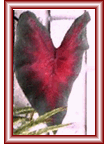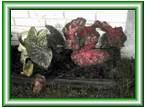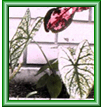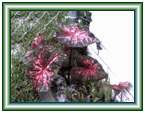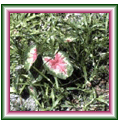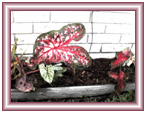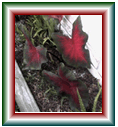
|
Caladiums, Caladium hortulanum, are tuberous perrenials grown for their heart-shaped leaves. Commonly known as Angel's Wings, they grow well in gardens, window boxes, or outdoor pots. Caldiums are native to the riverbanks of the Amazon. To enjoy the longest season, you should start them indoors at least a month before you will transplant them outside. Start the tubers in a mixture of 3 parts peat moss mixed with one part builder's sand. They should be planted under no more than 1/4 inch soil mixture and should be kept moist.
Tubers differ from true bulbs as they have no covering of dry leaves or no basal plate from which the roots grow. Their tough skin generates roots from its surface. They are short, fat, and rounded with a bumpy surface. The caladium tuber sprouts new tubers on the sides of the original. If in an outside garden, they should be planted in late spring and need temperatures of 70 - 90 degrees. They love light shade and need rich moist (not soggy) soil. Caladiums should be planted 2-3" under the soil and you should lightly apply a fertilizer about every 5-6 weeks. They can also be grown indoors as potted plants. Only place one or two tubers to a pot unless using a very large pot as they need plenty of room to grow. When the leaves start to die, stop fertilizing and cut back on the water. Remove the tubes from their soil and dry in the sun for two or three days. To store them for replanting next year, place the tubes in a single layer in a cardboard box or a clay pot. You should dust the roots with a combination insecticide/fungicide before storing. You can cover with sand, vermiculite, perlite, sawdust or peat moss. Make sure the tubes do not touch. Be sure to keep them in a warm, dry, well-ventilated area. If the tubes are not kept warm, (at temperatures of 55-60 degrees) they will rot. In some Southern areas (such as Florida), they can be used as annuals. Caladiums, while lovely, are also poisinous. All parts of the caladium are poisonous. Ingestion can cause severe irritation to the mouth and throat and may also be an irritant to the gastrointestinal tract. A great reference site on Caladiums is: Caladium World Below are some wonderful picfurs of my caladiums from my garden. Click on the thumbnails to see the larger image. All pictures/graphics copyright 2000.
|
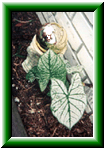

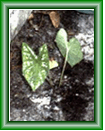

Back to Garden Guild
To turn off the butterfly, click on it.
